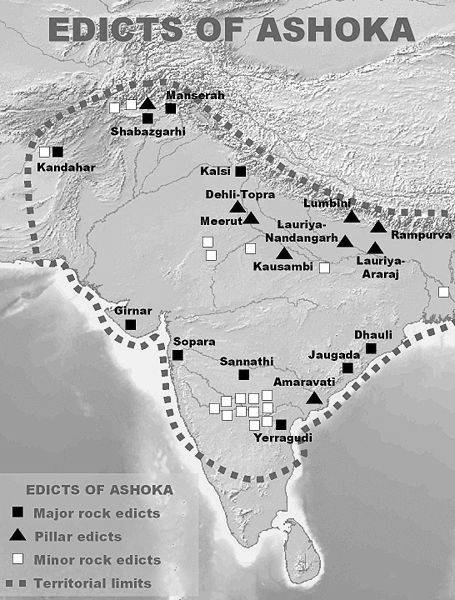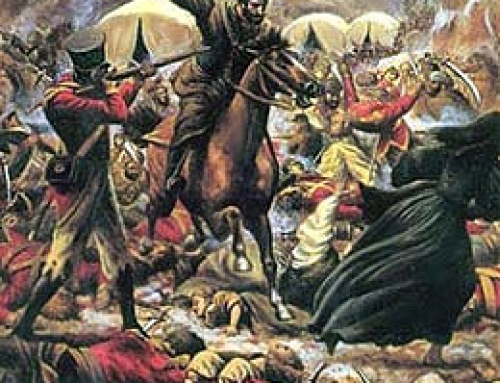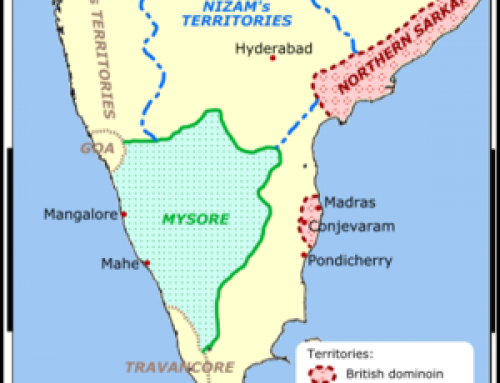Asoka’s Edicts & Inscriptions
The Edicts of Ashoka are in total 33 inscriptions written on the Pillars, boulders and cave walls of Mauryan Period, during the reign of the Emperor Ashok that are dispersed throughout the Indian Sub-continent covering India, Pakistan and Nepal.
These inscriptions are divided into three broad sections –
- Major Rock Edicts
- Pillar Rock Edicts
- Minor Rock Edicts
These edicts have mentioned that Buddhism as a religion had reached as far as Mediterranean under the Ashokan reign. Many Buddhist monuments had been created in the wide-spread area. In these edicts, Buddhism and the Buddha are also mentioned. But primarily these edicts focus more on social and moral precepts rather than the religious practices (or the philosophical dimension) of Buddhism during Ashoka’s reign.
A notable thing in these inscriptions is, that Ashoka refers to himself in many of these inscriptions as “Devampiyaa” which means “Beloved of the Gods” and “King Piyadassi.”
Language used: The inscriptions found in the eastern parts of Mauryan empire are written using the Brahmi script in Magadhi language. While in the western parts of the empire, the script used is Kharoshti, written in Prakrit. To add to the variety, one extract in the Edict 13 is written in Greek and Aramaic.
The world came to know of these details of Mauryan empire and Ashoka when the edicts and inscriptions were decoded by British Archaeologist James Princep.
Major Rock Edicts:
There are fourteen major rock edicts in series and two separate.
Major Rock Edict I – It Prohibits animal slaughter and bans festive gatherings. he mentions that only two peacocks and one deer were being killed in Asoka’s kitchen which he wanted to be discontinued.
Major Rock Edict II – This edict provides for care for man and animals. It also describes the presence of Pandyas , Satyapura and Keralputra Kingdoms of South India.
Major Rock Edict III – It mentions and guides about Generosity to Brahmans. This edict was issued after 12 years of Asoka’s coronation. It tells about the Yuktas which were subordinate officers and Pradesikas (who were district Heads) accompanied with Rajukas (Rural officers) would go to the all the parts of the kingdom every five years to spread the Dhamma Policy of Ashoka.
Major Rock Edict IV – It says that Dhammaghosa(sound of righteousness) is ideal to the mankind and not the Bherighosa(sound of war). It also talks about the impact of Dhamma on the society.
Major Rock Edict V – It concerns about the policy of people towards their slaves. “Dhammamahamatras” are mentioned in this edict as appointees of the state.
Major Rock Edict VI – This describes the King’s desire to stay informed about the conditions of the people of his regime constantly. Welfare measures for the people.
Major Rock Edict VII – Ashoka requests tolerance for all religions and sects. This is repaeted in 12th edict.
Major Rock Edict VIII – It describes Ashoka’s first Dhamma Yatra/visit to the Bodhgaya and Bodhi Tree.
Major Rock Edict IX – This edicts condemns popular ceremonies and stresses on Dhamma.
Major Rock Edict X – It condemns the desire for fame and glory of individual and stresses upon popularity of Dhamma.
Major Rock Edict XI – It elaborates on Dhamma(Moral Law).
Major Rock Edict XII – Here also he request for tolerance among different religions and sects, as mentioned in 7th edict.
Major Rock Edict XIII – Asoka mentions his victory over Kalinga . Also mentions Victory of Asoka’s Dhamma over Greek Kings, Antiochus of Syria, Ptolemy of Egypt, Antigonus of Macedonia, Magas of Cyrene, Alexander of Epirus and Cholas, Pandyas etc.
Major Rock Edict XIV – This describes the engraving of inscriptions installed in different parts of country.
Minor Rock Edicts:
Pillar Edicts:
The pillars edicts use two types of stones. One type is a spotted, white sandstone sourced from Mathura. Another type is a Buff colored Sandstone and Quartzite sourced from Amravati. There are a total 11 pillars that have been found in India and Nepal. These are found at Topra (Delhi) , Meerut, Kausambhi, rampurva, Champaran, Mehrauli, Sanchi, Sarnath, Rummindei, and Nigalisagar. All of these pillars are monolithis( made from single rock).
Pillar Edict I – It mentions about Ashoka’s principle of protection to people.
Pillar Edict II – It defines ‘dhamma’.
Pillar Edict III – It abolishes the practice of harshness, cruelty, anger, pride among his subjects as sins.
Pillar Edict IV – It deals with duties of Rajukas.
Pillar Edict V – This edicts describes the list of animals and birds which shall not be killed on listed days. Also there is another list of animals which must not be killed at all occasions.
Pillar Edict VI – It describes the Dhamma Policy of the state.
Pillar Edict VII – It describes the works done by Ashoka for fulfilment of the Dhamma Policy. He observes that all sects desire self control as well as purity of mind.





